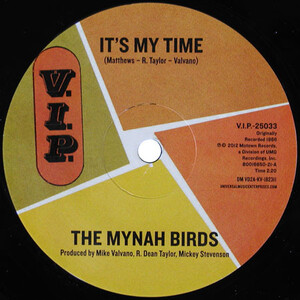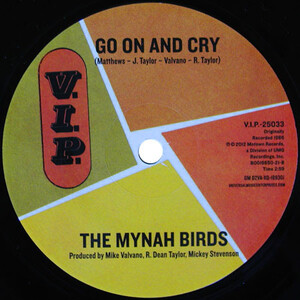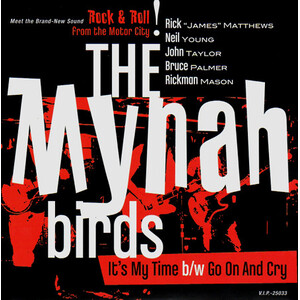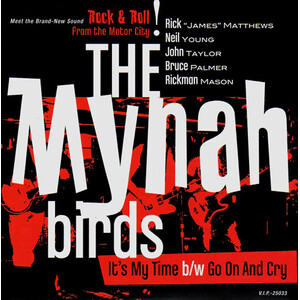Information/Write-up
Scheduled for release as a single on Motown’s V.I.P. subsidiary in spring ‘66, and assigned the catalogue number 25033, the garage/folk-rock classic “It’s My Time” (allegedly one of several Rick James/Neil Young collaborations but credited to Michael Valvano, Ricky James Matthews and R Dean Taylor in the boxed set) should have been a smash single.
Driven by James’s distinctive soulful voice and Young’s ringing 12-string guitar, the infectious “It’s My Time”, coupled with the contrasting “Go On and Cry”, a soft ballad credited to James, rhythm guitarist John Taylor and Motown staff writers, Michael Valvano and R Dean Taylor, had all of the ingredients to be a hit record.
But it was withdrawn when, half way through the recording of an album with producers William “Mickey” Stevenson, Michael Valvano and R Dean Taylor at Motown’s Hitsville studio, the band imploded in spectacular fashion.
James was AWOL from the US Navy, and his surrender to the FBI put an end to any further recordings. Left to reassess their futures, Neil Young and bass player Bruce Palmer promptly relocated to Los Angeles where they founded Buffalo Springfield. For Young it was the start of an illustrious career that would lead him to superstardom and a successful solo career.
But how did an interracial Canadian R&B band come to fall under Motown’s radar in the first place, and, more importantly, what happened to the rumoured album that was shelved?
To answer these questions, we need to go back to the autumn of ‘64 and a thriving Toronto live scene, into which stepped a young man wanted by the FBI: James Ambrose Johnson Jr.
Months shy of his 17th birthday, the Buffalo native made an instant impression after being invited to sing a few songs with Klaus Karl Kassbaum’s band at the El Patio coffeehouse in Toronto’s bohemian district, Yorkville Village. The future Steppenwolf bass player, better known as Nick St Nicholas, duly hired him as singer, and, dressed in the teenager’s US naval gear, they became the aptly named Sailorboys.
Besides Rick James and Nick St Nicholas, the line up at this time also comprised lead guitarist Ian Goble and drummer Rick Cameron. One early witness to the nascent group was Bev Davies, who later ran the Cellar coffeehouse in Yorkville where she befriended struggling folkie Neil Young.
For those in the know, Bev Davies was the woman that missed out on Neil Young and Bruce Palmer’s famous road trip to Los Angeles after being promised a place in the hearse.
“I was at Ontario College of Art fall 1964 [and] “I used to go to the El Patio to see Ricky James Matthews band,” says Davies. “I think Nick had an older brother who was at art school that year. The art school had a band called ‘the art school rubber band’ and he may have been in that. There was some connection between the band sometimes called The Sailors and the art school.”
Davies remembers James strutting around the stage. “Two outstanding songs that I remember him doing were ‘Hitch Hike’ and “I Got My Mojo Working’, she adds.
Local fame soon beckoned when eccentric businessman Colin Kerr, the owner of a local nightclub called the Mynah Bird, offered his services as a manager and renamed them after his favourite pet, a minor bird called Rajah. He also insisted the musicians adopt Rajah as band mascot and dress in minor bird colours on stage!
“He had [this] one minor bird that he would leave in a cage with a tape running 24-7 saying, ‘Hello, Ed Sullivan’ because he was quite convinced that sooner or later we’d end up on his [TV] show,” remembers new drummer Richie Grand.
In a more constructive move, Kerr engineered a recording deal with the Canadian arm of Columbia Records, which resulted in a hopelessly rare one-off single – the R&B belter “Mynah Bird Hop”, coupled with the calypso-flavoured “Mynah Bird Song”.
Both sides of the single were penned by Colin’s brother, the late Ben Kerr, and featured another future Steppenwolf member, John Goadsby (aka Goldie McJohn) on organ plus new guitarist Frank Iozzo (aka Arnel).
Issued in early ’65 with the catalogue number C4-2660, the single bombed. Yet despite its chart failure, the two tracks offer a fascinating glimpse into James’s formative years as a singer. Even as a teenager, his charisma and immense talent is clearly evident.
Of the two tracks, “Mynah Birds Hop”, is by far the more impressive and finds the teenager sharing vocals with a man nearly 10 years’ his age – the late Jimmy Livingston, who co-fronted The Mynah Birds for a few months and would go on to front The Just Us, The Tripp, Livingston’s Journey and Heather Merryweather.
One of rock’s true madcaps, Livingston’s off-the-wall stage persona was way ahead of its time – readers are advised to check out The Tripp on Canadian filmmaker Bruce McDonald’s three-part documentary series Yonge Street: Toronto Rock & Roll Stories, where the singer’s unnerving performance beats Joy Division’s Ian Curtis to the punch by 10 years.
Livingston later decamped to L.A where his prodigious consumption of hallucinogenic drugs would tragically see him fall into the Syd Barratt/Skip Spence orbit of rock casualties.
The troubled singer was but one of many musicians that would pass through The Mynah Birds’ ranks during late ‘64/early ’65; another journeyman being future Mandala, James Gang and Guess Who guitarist, the late Domenic Troiano.
But it was arguably the arrival of the late Bruce Palmer, traded with Nick St Nicholas from local rivals, Jack London & The Sparrows (later to morph into Steppenwolf) that shifted The Mynah Birds up a gear.
Soon after Palmer’s arrival, Kerr landed the band an important showcase gig at the Collonade Theatre in downtown Toronto and, according to Grand, in an inspired move he paid hundreds of girls to rush the band’s limo as it pulled up outside the venue!
The writing was on the wall, however, and by late spring ’65, The Mynah Birds had split from their eccentric manager. “We broke away from him and went with another little promoter,” remembers Grand, who left soon afterwards to join The Stormy Clovers, the first group to perform Leonard Cohen songs. “We went to Montreal as The Swinging Doors and played at the Esquire Show Bar.”
Left with the band name, James and Palmer secured the patronage of well-healed businessman John Eaton, and in June 1965 brought in three musicians from Brantford, Ontario band, The Bunkys – lead guitarist Tom Morgan, rhythm guitarist and songwriter John Taylor and drummer Rick Mason.
Eschewing the Kerr wardrobe and decked in clothes to match their idols, The Rolling Stones, The new-look Mynah Birds soon turned heads.
One was the Canadian Broadcasting Corporation, which, according to Mason, filmed the band for a long-lost documentary while playing at the Devil’s Den. “CBC came down the stairs and filmed the whole night of us,” says Mason. “Somewhere in their archives they have the footage of us.”
Eager to get a foot in the fledging Canadian rock market, one of Eaton’s first moves was to buy the musicians some new equipment and to set up an expense account. They also acquired a new manager, a shady character known as Morley Shelman, who was suspected of pocketing most of the money Eaton forwarded them.
Nevertheless, it was Shelman who used his connections with actor Sal Mineo to pique the interest of Motown Records. In October 1965, an awe struck band drove down to Detroit to audition personally for Berry Gordy and Smokey Robinson.
According to Garry Graff and Daniel Durchholz in the excellent Neil Young: Long May You Run: The Illustrated History, The Mynah Birds got as far as taping a backing track for “No Greater Love”, written by Howard Lemon and produced by Harvey Fuqua.
But for Tom Morgan, the session was a turning point. Sensing the label was only interested in Rick James, he bailed out two months later making way for an unlikely replacement – struggling folkie Neil Young.
Rick Mason remembers Young’s first job with the band – the Inferno, a club on Toronto’s east side in early January 1966. “They put rubber gym mats out for us to play on! The first song we go to do, Neil goes up to do his lead and unplugs his guitar. He plays the whole lead without his guitar plugged in!”
Soon after, the new line up returned to Detroit to begin sessions for an album, but only completed four tracks, cut between 18-26 January. Mason remembers the label being a hard taskmaster. “Twenty-four seven, day and night until we dropped,” is how he describes the workload.
“Neil used a 12-string a lot,” he continues. “But we never did anything as a band. It was all done in parts and they put it together. Then everybody would drop in and do songs with us, like Smokey Robinson and Tammi Terrell.”
Several of the song titles are listed on the Broadcast Music Inc (BMI) website. Only one is credited to Neil Young: “I’ll Wait Forever” which is listed as a co-write with Ricky James Matthews, Michael Valvano and R Dean Taylor, and was completed at the January sessions.
The other finished track is “I Got You (In My Soul)”, a Rick James/John Taylor co-write that sounds suspiciously like a direct lift from Van Morrison and Them’s ‘Little Girl”!
John Taylor’s widow Carolyn has five separate song-writing contracts signed by Rick James and her late husband for Jobete Music, dated 18 January 1966. These include “Go On and Cry” and “I Got You (In My Soul)”, as well as three previously unknown songs – “We Gotta Go”, “Don’t Change Your Mind” and “Pretty Words”.
According to an article in Billboard, dated 5 March 1966, The Mynah Birds only recorded four tracks in January but had plans to return to Detroit the next month to undertake further recordings.
“The Mynah Birds are billing themselves as the first Canadian group to be signed by Tamla Motown, with the first single under their new recording and management contract to be released shortly, it’s ‘I’ve Got You [In My Soul]’, written by lead singer Rick James [sic], one of the four numbers cut last month at the Motown studios in Detroit,” ran the review.
It then added: “The group’s personal manager, Morley Shelman, reports they’ll return to Detroit next month for more sessions with an album in sight and talk of US tour upcoming.”
Regrouping in Toronto a week after the first batch of sessions, The Mynah Birds were billed to play the El Patio in Yorkville Village on 11-13 February when news of James’s AWOL status reached Motown. The April sessions were duly scrapped, and with James in the FBI’s custody, The Mynah Birds’ career derailed. But that’s not quite the end of the story.
With Young and Palmer heading to Los Angeles, remaining members John Taylor and Rick Mason kept The Mynah Birds going for another year. Bringing back former member Tom Morgan alongside The Bunkys’ bass player John Klassen and new singer Mark Smith, the group gigged incessantly before finally dissolving in spring 1967.
Not long after, and having served time in military prison, Rick James was offered a second shot at Motown. Pulling together yet another version of The Mynah Birds with former David Clayton-Thomas sidemen, guitarist Bill Ross and drummer Al Morrison, plus bass player/singer Neil Lillie (aka Neil Merryweather) from The Tripp, they rehearsed at the label’s Gold Star studio before laying down a couple of backing tracks at Hitsville with R Dean Taylor in the producer’s chair and an unknown organist.
Session logs for 21 June 1967 reveal that two songs – “Masquerade” and “Fantasy” were cut before a studio dispute curtailed the sessions and irrevocably split the band, leaving Rick James to go on to a plethora of fascinating groups such as Salt & Pepper, Heaven & Earth, Great White Cane and The Stone City Band before finally striking gold with “Super Freak” in 1981.
While the Motown sessions in January 1966 provide a tantalising glimpse of what might have been had James’s arrest not scuppered the record deal, it would not be the last time that Rick James and Neil Young would cross paths.
Watch this space for the next chapter!
-Nick Warburton






No Comments